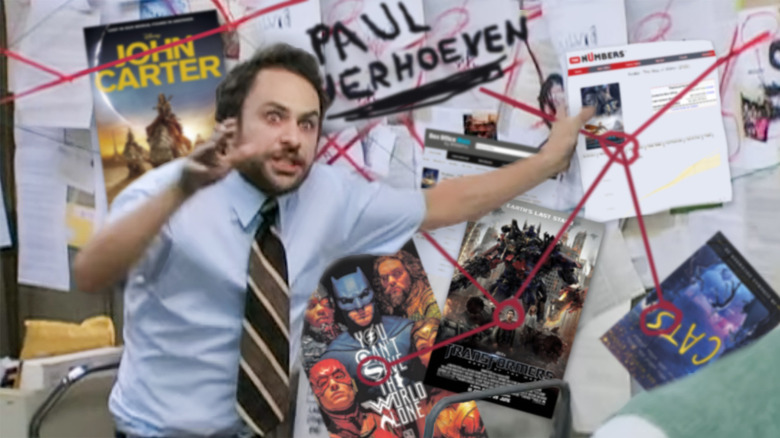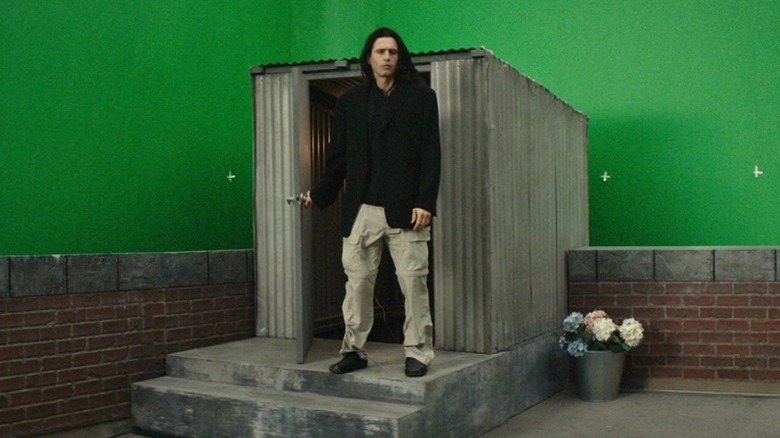Box Office Hit Or Box Office Bomb? A Rough Guide To The Mysteries Of Movie Math
Movies are not defined as a success (or failure for that matter) by any one, individual measure. But while a film certainly can live on well beyond its life in theaters, what a title makes at the box office in ticket sales is certainly one very loud and important measure of success — or lack thereof. At the end of the day, the movie business is a business, and these pieces of art have to make financial sense. That being the case, it's not difficult to trace a line from what a movie makes from ticket sales, and how successful it is perceived as being.
In the '80s and '90s, and early 2000s, things were a bit different; the home video market was always there to help bail a movie out. There are near-countless classics that became classics thanks to cable, VHS, and DVD, like "The Shawshank Redemption." Unfortunately, the home video market is now a drop in the bucket thanks to streaming and can't be relied on as a huge revenue source like it used to.
So, let's ask a simple question: What is the dividing line between success and failure at the box office? What does it take for a movie to be considered a hit in the modern era? What does it take for one to be considered a misfire? We're going to go over some guidelines to offer a better understanding of the math that drives the movie business, with the understanding that it's rough calculations and not an exact science.
How much does it cost to make a movie anyway?
Movies are not a one-cost-fits-all situation — far from it. There are movies such as "Paranormal Activity" that were made on an absolute shoestring budget, in that case just $15,000. And the movie ultimately went on to make nearly $200 million at the global box office. So yeah, safe to say Paramount Pictures did pretty well with that one. However, a production budget of $15,000 doesn't mean the movie only cost $15,000 and nothing more. After "Paranormal Activity" was acquired, a new ending was shot, which cost the studio a little something. But the biggest expense at that point was marketing.
When a movie's budget is reported, that figure does not account for the marketing. This is where things can get tricky for a smaller horror movie like "Paranormal Activity." Sure, it only cost $15,000 to shoot the found-footage flick, but then someone has to launch a P&A (print and advertising) campaign to help sell tickets. That doesn't come cheap. Unlike production budgets, marketing budgets are rarely made public, but it's safe to say it cost the studio a whole lot more than $15,000 to market this particular film.
In the end, that marketing spend, coupled with the budget, must be recouped before a movie can get into the black — passing its break-even point to become profitable. Until that break-even point is reached, the movie is in the red, meaning the studio is still in the phase of attempting to get its money back.
Some simple box office movie math
Alright, so how does all of this work out in the end? There are some very rough rules of thumb that can be followed to determine whether or not a movie was profitable or not. Say a movie has a $150 million budget, which is pretty standard for a blockbuster movie (oftentimes they cost more). Generally, you would double the budget figure to account for marketing and other expenses, bringing the total cost to $300 million.
That means the movie needs to earn $300 million in revenue to break even. But that doesn't mean if it makes $300 million at the box office it's in the black; as another rule of thumb, theaters keep around 50% of the ticket sales before the studio gets its cut. (Again, it needs to be stressed that this is rough, guideline math to get us in the ballpark.) That being the case, a movie with a $150 million budget would, in all likelihood, require about a $300 million investment, and need to earn $600 million at the global box office to break even, give or take.
Let's take a blockbuster like "The Batman" to apply this to it and see how it works out. Director Matt Reeves' DC Comics adaptation had a budget said to be in the $185 million range. If we double that, we're looking at a $370 million investment. With that in mind, Warner Bros. probably needed around $740 million in ticket sales to break even. "The Batman" was a hit, taking in $770.9 million at the global box office. So yes, it did likely manage to get into the black during its theatrical run.
Other revenue streams
Let's keep the focus on "The Batman" for a moment. The good news for this movie is that it almost certainly turned a profit, albeit a relatively small one, in its theatrical run. That often isn't the case for a blockbuster-sized movie. So, what happens if a movie doesn't make back all of its money in theaters? It comes down to other revenue streams, referred to as ancillary revenue streams. This includes Blu-ray/DVD sales (small though they may be these days), cable rights, VOD/digital rentals, merchandise, and other such ways of generating money beyond the box office. In the case of a big superhero movie, merchandise can be a gigantic part of the equation.
These numbers get trickier to compute due to a lack of publicly available data, but for a movie like "The Batman," all of these revenue streams will be icing on the cake because it was successful in theaters. Warner Bros. can now collect from this film in perpetuity. For as long as Blu-rays are sold, the movie is streamed, or toys are purchased, there is profit to be made. In the case of a movie that perhaps didn't get into profits in theaters, these revenue streams can, over time, get the movie into the black. Again, that used to be much easier when home video sales were higher, as digital rentals/purchases and streaming revenue have yet to reach a point of generating the same levels of revenue.
Looking at another 2022 movie, Jordan Peele's "NOPE," we can see how ancillary revenues might save the day. The film made $171 million against a reported $68 million budget. So no, it did not hit its break-even point in theaters using our rough math from earlier, even if Universal was thrifty with the marketing budget. That said, over time, thanks to streaming, likely solid VOD sales, and even merch (you can buy one of the "Scorpion King" crew hoodies online), "NOPE" can eventually make its way to the break-even point.
Complicating factors
I need to emphasize once more that this is all very much intended to be rough guidelines to offer a better understanding of how financial success and/or failure are calculated in the movie business. When that movie you liked doesn't get a sequel, using this math can provide some insight into why. When a movie you personally hated or was trashed by critics does get a sequel, the numbers can explain that as well. In the end, studios are in this to make money.
There are, naturally, caveats to all of this. For one, film studios are notorious for creative accounting that attempts to show that movies are still in the red. Why, exactly? There's the usual corporate motivation to reduce tax bills, but it's also to avoid paying out royalties to writers, directors, or actors who may have had stipulations in their contracts stating that they would get a certain cut of the net profits. So, there are studio accountants whose job it is to try and make it look like even very successful movies were not profitable ventures.
As for the specifics of a profit breakdown? Those are rarely provided, but A.Frame, the Academy of Motion Picture Arts and Science's digital magazine, did offer some rare insight on that front with "Skyfall" in 2021. It shows that the movie made $1.1 billion at the box office, with $400 million going to theaters, $186 million for production, $117 million for advertising, $27.7 million to make prints of the movie for theaters, and other costs totaling $24.3 million. What did that leave? $57 million in profits for Sony, the distributor, $179 million for the studio, MGM, and $109 million for the rights holders, the Broccoli family. So that particular example does, indeed, demonstrate that the rough math comes pretty damn close to the real numbers.




